A Brief History of Phitsanulok during the Sukhothai and Ayutthayan Periods
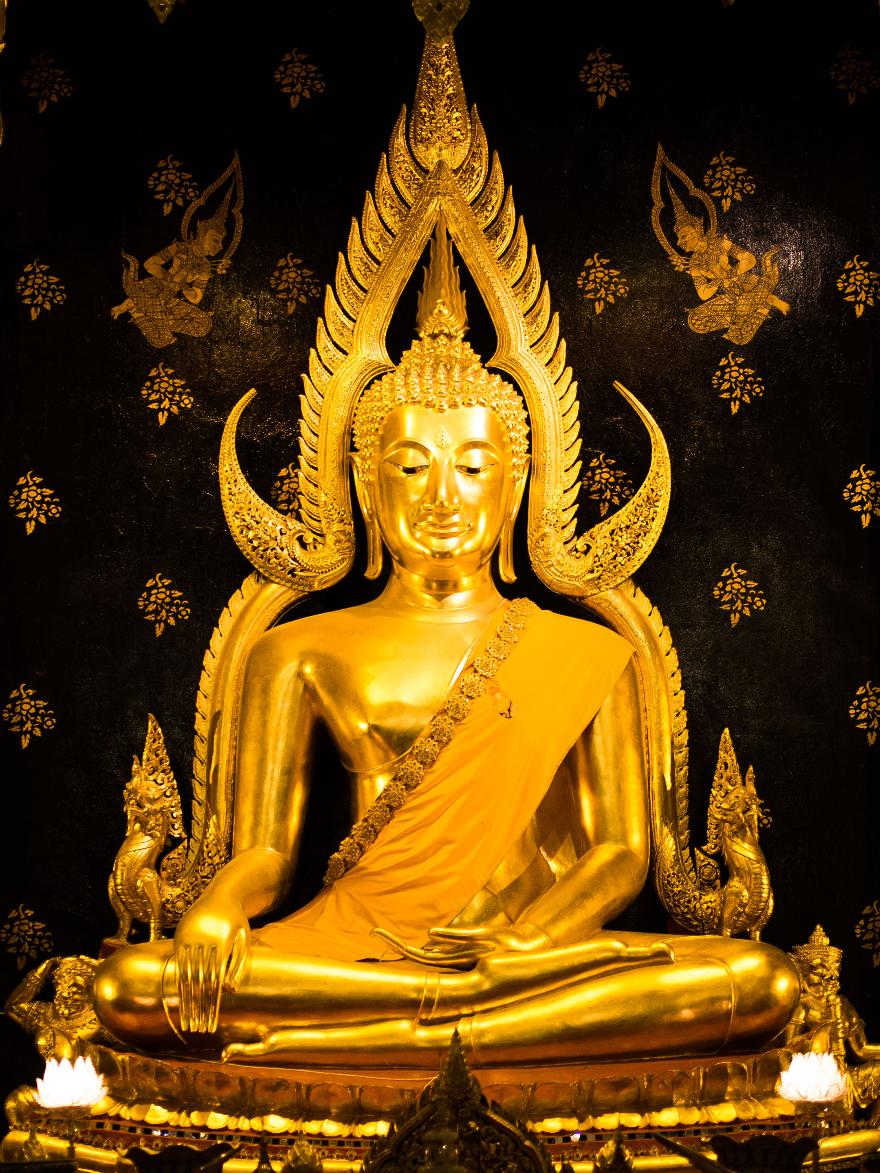
h
The history of modern Phitsanulok can be traced back to the 11th Century, when its role was a Khmer town known as Song Khwae (Two Rivers) situated on the confluence of the Nan and the Khwae Noi rivers then near the site where Wat Chula Mani is today. King Luthai relocated the town during his reign. The Khmer, the builders of Angkor Wat and the Bayon and many other temples, were the dominant power of the period with their empire extending north into Laos, east to the coastal kingdoms of the Dai-Viet and Champa (modern-day Vietnam,) west to the Burman Empire, and along the northern Malay peninsula to the shores of the Andaman Sea and encompassing most of modern-day Thailand.
Song Khwae stood at the meeting point of the two rivers and held a position of considerable strategic importance with its ability to control river traffic. Roads were almost an unknown in this time period and outside towns and cities and people, animals, and goods used the rivers, in the same manner, we would use the road network, and Song Khwae's central position ensured its importance. It was a time of change. To the north, the Singhanavati Kingdom bordered the Khmer Empire and pushed its domains southwards finally establishing a capital city in Nakhon Thai (about 100 miles north of Song Khwae.) Further north, wars raged in China, driving many people southwards into what were the relatively underpopulated but often heavily forested lands to the south, providing both an elite and farmers who were looking to establish themselves.
The Khmer Empire was imperceptibly moving toward its gradual decline. One of its greatest kings, King Jayavarman VII had retaken the sacred city of Angkor from the Cham invaders and extracted his retribution when invading their lands and making them part of the Khmer Empire. Under his rule he built the city within a city of Angkor Thom and the world famous temple of the Bayon. The KhmerEmpire was at its greatest extent yet was about to fall.
The Khmer Empire came under threat after over-extending itself during the reign of King Jayavarman VII (1181-1220) at the point where the Khmer Empire reached its zenith and its greatest extent. Angkor was reputed to have been a city of over one million inhabitants - the largest city in the world at the time. The great Khmer king was followed by King Indravarman II. The people were exhausted after the demands placed on them by the late king. The new King looked to withdraw from the many wars that the Khmer were engaged in, halt building projects, and repair the neglected infrastructure of the both the cities and of agriculture.
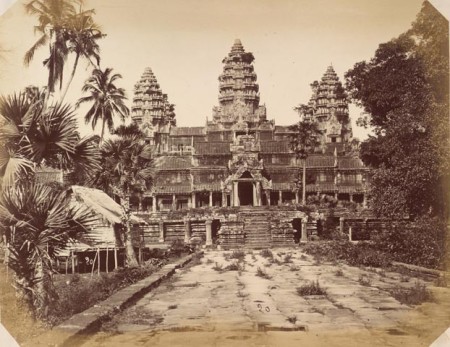
e
The Kingdom of Sukhothai, at that time a loose confederation of tribes bordering the Yom River came together to make a stand against their Khmer masters. Two petty kings, Pho Khun Pha Mu'ang and Pho Khun Bang Klang, joined forces and routed the Khmer army of General Khlonlampong. The Khmer retreated, never to return. George Cœdès recorded the following from the Nagara Jum in 'The Origins of the Sukhodaya Dynasty' published in the Journal of the Siam Society 14. No.1 (1921.) "Afterwards Pho Khun Pha Mu'ang consecrated …. Pho Khun Bang Klang as Chao Mu'ang Sukhothai, and conferred his own name on his ally, that is to say the name of King Sri Indrapatindraditya."
The Kingdom of Sukhothai drew inspiration from its past under the Khmer, its neighboring countries, and the people fleeing from the unrest in China to the north. Under King Ram Khamheang, the Kingdom stretched from Phitsanulok and beyond in the east, to the Malay Peninsula in the south and the Burman Empire in the west. King Ram Khamheang was more than a military leader. He used marriage and diplomacy in much the same way the Khmer did to expand his influence. He embraced Theravada Buddhism and, although the tradition animist practices continued, made it his kingdoms official religion as can still be evidenced by a visit to Sukhothai Historical Park.
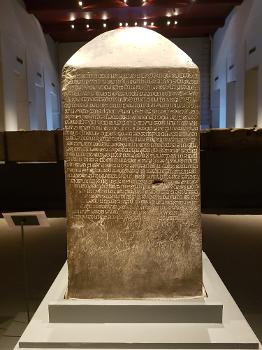
"There is fish in the water and rice in the field. The lord of the realm does not levy toll on his subjects for traveling the roads, they lead their cattle to trade or ride their horses to sell; whoever wants to trade in horses does so ... he does not covet it, when he see someone's wealth he does not get angry. "
Quote from the Ram Khamhaeng Inscription (Opposite)
The original is now housed in the Bangkok National Museum but a replica can be found in the Sukhothai Heritage Museum in Sukhothai Historical Park.
The Kingdom of Sukhothai flourished before being eclipsed by the newly founded Kingdom of Ayutthaya to its south, but its legacy remains in the hearts and minds of the Thai people. Sukhothai arts as seen in the temples and images of Buddha took on their own unique form, the Code of Wareru which formed the basis for Thai law until 1908 was developed during this period, the Thai written language was developed, and the role of the king who ruled his subjects as a 'father who looks after his children' differed greatly from the rule of the Khmer and the Ayutthayan Kingdom where the king was Devaraja or Chakravartin (supreme ruler.) Known more commonly as King Si Inthrathit, his statue (top left) can be found as you enter Nakhon Thai from the south.
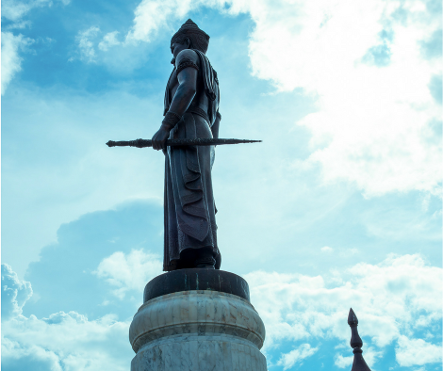
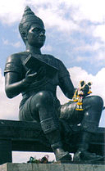
Sukhothai expanded rapidly, particularly under King Ram Khamhaeng the Great, not only filling the void left by the retreating Khmer but in establishing itself as a religious center dedicated to Theravada Buddhism the remains of which can be seen today.
The ruins of Sukhothai are more compact than those of Ayutthaya and well worth a visit.
The statue of King Ram Khamhaeng (Opposite) is located in Sukhothai National Park.
Kingdom of Ayutthaya was founded in 1351 and in due course conquered both the Sukhothai Kingdom and much of the Khmer Empire. The story of the rise and fall of both these kingdoms can be found in my books The Kings of Angkor and The Kings of Ayutthaya.
The latter is published in Thailand by Silkworm Books and is available throughout Thailand and worldwide, although not in Phitsanulok. Song Khwae (later called both Chinnarat and Phitsanulok) lies geographically east but between Ayutthaya and Sukhothai and due both to its proximity and growing importance found itself embroiled in the drawn-out conquest between the two kingdoms. Opposite: The U Thong (King Ramathibodi) monument in Ayutthaya.
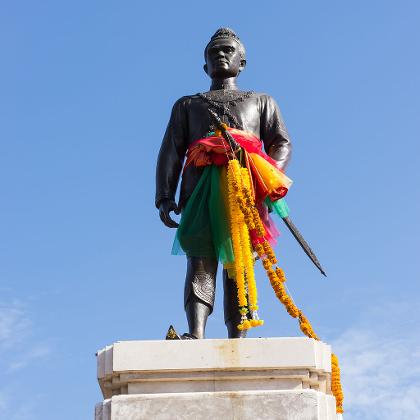
Song Khwae (later called both Chinnarat and Phitsanulok) lies geographically east but between Ayutthaya and Sukhothai and due both to its proximity and growing importance found itself embroiled in the drawn-out conquest between the two kingdoms.
The leading houses from two cities dominated Ayutthaya; Lopburi and Suphanburi. The different factions within these cities fought for political control over the kings of Ayutthaya. Suphanburi quested for revenge against Sukhothai who had conquered the city following the fall of the Khmer and Lopburi wanted to put right the wrongs committed to it by the Khmer over the centuries, the enslavement of its people and the high taxation demanded. The first king of Ayutthaya was King Ramathibodi (known more commonly as U-Thong.) He was of the House of Lopburi and during his reign set out on what would be the first of many attempts to conquer the Khmer and their capital Angkor. (It was not until 1431 that an Ayutthayan army under King Borommaracha II finally took the city, sacked it, and forced the Khmer to flee south.)
TheKingdom of Ayutthaya differed from the Kingdom of Sukhothai to its north in that it followed the model of government used by the Khmer who were advised by Hindu Brahmin priests skilled. not only in the ways of government, but in construction, agriculture, hydraulics, and management.
The King was revered as a supreme being. The weakness of the system lay in the weakness of the King. The Khmer king, King Jayavarman II united his people under the Hindu banner that dominated at that time as Devaraja, Lord of the Universe who is king. The King was the supreme being. King Ramathibodi, a Buddhist not a Hindu aspired to be Chakravartin based on the Indian concept of world ruler derived from the Sanskrit chakra, 'wheel,' and 'vartin,' one who turns. Chakravartin can be understood as a ruler 'whose chariot wheels roll everywhere,' or 'one who is unobstructed.' He and the kings who followed him were viewed by their subjects as a universal monarch in much the same was as a Devaraja was in the Hindu religion.
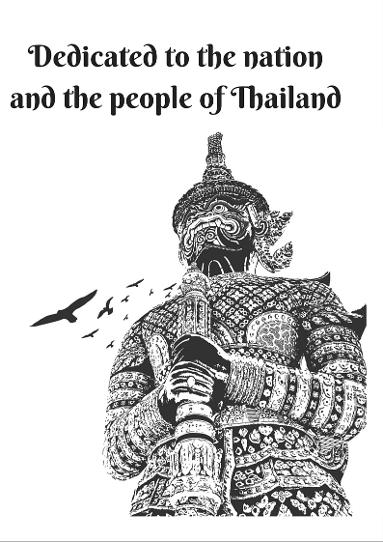
The Brahmin, who acted as advisers to the King, put forward the concept of 'Mandala” where chiefs or warlords would come together under the protection of one leader in return for protection for themselves. They would offer their allegiance in return for protection.
When the city of Ayutthaya was founded by King Ramathibodi its reach was limited, but it expanded rapidly. The city of Phitsanulok lay on the flood plain close to the then northern border of the Kingdom of Ayutthaya. It was one of the four “cardinal points” decreed by the Brahmin advisers to define Ayutthaya's Mandala, the cities that surround and protect the capital. Ayutthaya lay at the center of the kingdom, with the four cardinal points around it. Phitsanulok to the north, Phrapradaeng to the south, Nakhon Nayok to the east, and Suphanburi to the west. These muang lik luang, cities of the royal sons, were ruled by the sons of the king or by his close family or most trusted friends. The cities served to protect and enclose Ayutthaya.
Shortly after Ayutthaya was founded the city of Nakon Nayok was attacked and integrated into the Kingdom of Ayutthaya. It is reasonable to assume that Phitsanulok either joined willingly or faced war. Phitsanolok became an integral part of the Kingdom of Ayutthaya.Kin
When King Ramathibodi died, he was succeeded by King Borommaracha I who was of the House of Suphanburi. They wanted revenge against Sukhothai,. At some point, Phitsanulok declared for Ayutthaya. Sukhothai was by now an inward-looking kingdom focused on its Buddhist religion but under a new king, King Maha Thammaracha they recognised the threat from Ayutthaya adopting a military stance and regaining much of their territory lost in previous years to Ayutthaya. King Borommaracha I visited Phitsanulok in 1371 where he was shown the legacies of Phitsanulok's association with Sukhothai including Wat Phuttha Phra Chinnarat and Wat Phra Si Satsadaram. Within Wat Phuttha Phra Chinnarat the King would have viewed the red glazed image of Phra Buddha Chinnarat (it was not covered in gold leaf until the reign of King Ekathotsarot early in the 1600's.)

Above: Wat Phra Si Rattana Mahathat (Photo by JJ Harrison www.jjharrison.com.au)
Phitsanulok is home to Wat Phra Si Rattana Mahathat (known locally as Wat Yi – the Big Temple.) The temple was built in 1357 during the reign of the pious King Lu Thai of Sukhothai. Within the temple, the King wanted three bronze images and sent for sculptors from Si Satchanalai, Chiang Sen and Hariphunchai. The first two castings proceeded well but the third required three attempts to finish it. A 'Rusi,' an old hermit clad in a white robe told the King that he could create an image that would please his lord. The image he created was the Chinnarat in the Sukhothai style, famed to this day. The other two images, Phra Chinnasi and Phra Si Satsada, that were originally housed in the temple were later moved to Wat Bowonniwet in Bangkok. The reign of King Lu Thai also saw the building of Wat Phra Phuttha Chinna Si and Wat Phra Si Satsadaram
In 1371, King Borommaracha led his army against Sukhothai but was unable to progress further than the cities of Nakon Phangka and Phichit. The war continued. In 1376 King Borommaracha failed to take Kamphaeng Phet gaining the city the sobriquet of the 'Wall of Diamonds.” It was not until 1378 that the King of Sukhothai surrendered and offered his suzerainty to the King of Ayutthaya. The war was not that easily won and rumbled on over the following decades. Subsequent Ayutthayan kings divided the vassal kingdom between two brothers in an attempt to weaken it, and finally moved the Sukhothai Dynasty to Phitsanulok where it would be more under the influence of Ayutthaya. Sukhothai was now part of Ayutthaya with its kings residing in Phitsanulok, and as a result, Phitsanulok became acknowledged as Ayutthaya's second city. It became the convention that the king would send the Upparat, the heir apparent as governor of Phitsanulok in order to gain experience for his eventual kingship.
According to Brahmanic belief, if a monarch possessed one or more 'white’ elephants,' it was a glorious and happy sign. King Trailok is reputed to have possessed the first. In the Thai language, they are called albino, not white, indicating “pale yellow eyes and white nails”, with white hair. The rough skin was either pink all over or had pink patches on the head, trunk, or forelegs. A White Elephant need not be white.
“They were not worshipped for themselves and were regarded as an appendage to the King’s majesty.” In Thailand, white elephants ( chang phueak, also known as Pink Elephants) are considered sacred and are a symbol of royal power; all those discovered are presented to the king (although this presentation is usually a ceremonial one—the elephants are not actually taken into captivity). Historically, the status of kings has been evaluated by the number of white elephants in their possession.
In 1448, King Borommatrailokanat, more commonly known as King Trailok came to the throne. His father, King Borommaracha II had died on campaign against the kingdom of Lan Na to the north. His death left King Tilokkarat to claim the kingship of Lan Na. King Trailok would have a long and glorious reign ushering in many changes to society, but his reign was also remembered for the on-going war against Lan Na.
The new King's father was from the house of Suphanburi, and his mother was a princess of Sukhothai. As Upparat he was given the governorship of Phitsanulok. It was his father, King Borommaracha II who had moved the Kings of Sukhothai to Phitsanulok. The two sides of his background looked set to collide as he knew many within the royal family would not be happy with a King of Ayutthaya as King of Sukhothai, a kingdom that still valued its independence and its approach to the way a nation should be ruled. The 'Pho” approach of Sukhothai still influences the Thai monarchy to this day.
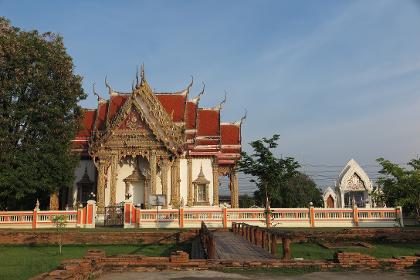
Wat Chula Mani
It was in 1463 that King Trailok moved his capital from Ayutthaya to Phitsanulok to be nearer the enemy (although it is recorded that he was also getting increasingly tired of court intrigue.) He placed his son as King, not Upparat, of Ayutthaya. The city walls were strengthened in preparation and just in time as Phitsanulok came under siege in the years 1459 and 1460. King Trailok had already ordered that Wat Chula Mani, the oldest temple in Phitsanulok should have a viharn (an assembly hall) added in preparation for him entering the monkhood . Now he took his army and moved north to Phitsanulok to ensure the city not only would not fall but to could be used as a base to operate northwards toward Lan Na and its capital of Chiang Mai.
Under King Trailok significant reforms to the Kingdom were undertaken. To the north, King Tilokkarat of Lan Na proved himself not only to be a wise ruler but one bent on conquest. The war with Lan Na continued with Ayutthaya suffering major defeats on both sea and land. Prince Yuthisathian of Sukhothai, second in line to the throne of Sukhothai had declared himself as an independent King of Sukhothai and formed an alliance with King Tilokkarat. A major attack by King Tilokkarat and the self-proclaimed King Yuthisathian failed to materialise as planned when the army of Lan Na were forced to return when a Chinese army attacked Chiang Mai. King Borommaracha II, the son of King Trailok, met the pretender King of Sukhothai in battle defeating his leading general, General Han Nakhon in Yuddhahatthi, the elephant battle where the winner can claim victory over the battle. These events weakened both Lan Na and Sukhothai, and a peace treaty was signed in 1464.
Moving his capital to revitalised Phitsanulok. Temples and palaces were renovated and new ones established. Workers and artisans came into Phitsanulok, making it a vibrant, cosmopolitan city and one at the forefront of a change in thinking that gripped much of south-east Asia at the time. It was in 1465 that King Trailok entered the monkhood at the recently completed Wat Chula Mani. He was the first King to do so. It is speculated that he did not use Phra Buddha Chinnarat as a sign of respect to his family from Sukhothai although the convention of the time dictated that if a king moved his seat of government, he had to move his entire court with the King being obligated to build a monastery of suitable grandeur.
King's other predicament lay in the fact that Phra Buddha Chinnarat (Wat Yai - the Big Temple as it is known locally) was regarded as the leading temple in the north if not the whole of the kingdom of Ayutthaya.
Wat Chula Mani is considered to be the oldest temple in Phitsanulok with its roots dating back to the time of the Khmer (Khmer Temple ruins opposite). The temple underwent considerable changes to enable King Trailok to enter the monkhood. The King chose to have five men ordained before him. They were chosen by the King based on their learning, their potential, and their austere nature. An ordained monk from Sri Lanka, the home of Theravada Buddhism officiated, and neighboring kings either attended or sent representatives as in the case of King Tilokkarat of Lan Na in their stead along with royal gifts suitable for such an occasion.
Over 2,300 people attended the ceremony of the king entering the monkhood. The king became a monk at Wat Chula Mani. His move spearheaded a period of religious revival as other regional kings sought to show their dedication to the Buddhist doctrine and peace reigned, but only for a few years.
King Tilokkarat of Lan Na was also a strong patron of Thervada Buddhism and hosted the Buddhist Council of Tripitaka Recompilation in Chiang Mai (1477.)Til
Following an accusation taking animist actions against the King of Lan Na (i.e. bones left at inappropriate sites, rituals and the burning of holy relics) King Tilokkarat had the entire diplomatic presence of Ayutthaya in Chiang Mai killed after he had sent them from the city. Angered, he then marched his army south towards Phitsanulok only to be beaten back. A stalemate ensued and held until King Tilokkarat died in 1487. Both kings relying on each other's word rather than sign a formal peace treaty. King Trailok, his court still in Phitsanulok, died the following years after reigning for forty years. Phitsanulok had been the capital of the Kingdom of Ayutthaya for twenty-five years (1463 – 88) King Borommaracha II returned the court to Ayutthaya.
As second city Phitsanulok often found it on the fringes of events unfolding in Ayutthaya and, on occasions was dragged into many of the issues of the capital city.
One of the most colourful characters in Ayutthayan history is the Lady Si Suda Chan, the wife of King Chairacha (1534 -46) and a daughter of Lopburi who rose to a position where she was de facto queen before being forced to flee and eventually meeting her death. Her machinations were watched from afar by the Burman king, King Tabinshwehti. He saw the internecine strife of the battle for the throne of Ayutthaya weaken the city. One of the first of the 'Gunpowder Kings' he embraced the new weapons brought by the Portuguese and left his mountainous kingdom of Toungoo in central Burma to gradually claim the country as his. He cast his eye on Ayutthaya.
The defeat of Lady Si Suda Chan was in no small part down to two individuals, Khun Phirenthrathep and Khun Intharathep who enabled Prince Thianracha to claim the throne of Ayutthaya as King Maha Chakkraphat. In gratitude, King Maha Chakkraphat gave Prince Intharathep the title of Chao Phraya and the regency of the southern city of Nakhon Si Thammarat (Ligor) while he gave Khun Phirenthrathep, a prince of Sukhothai the ancient Sukhothai title of Maha Thammaracha as well as the governorship of Phitsanulok and the hand of his daughter in marriage.
King Maha Chakkraphat was aware of the threat posed by King Tabinshwehti but had to fight first against the Khmer who raided the south coast and where the king's eldest son Prince Ong died while astride an elephant. Shortly after the Khmer had been driven back King Tabinshwehti attacked via the southern Three Pagodas Pass route in what has been dubbed 'The First War of the White Elephant'. His attack ultimately proved unsuccessful but gave Ayutthaya one its unlikely heroines. The Ayutthayan force came out from behind the walls of Ayutthaya and gave battle on the Lumpli Plain. King Maha Chakkraphat found himself in trouble pursued by the viceroy of Prome. Queen Suriyothai and her daughter Princess Boromdhilok sat on top of the same elephant dressed as men. Both were killed in the battle.
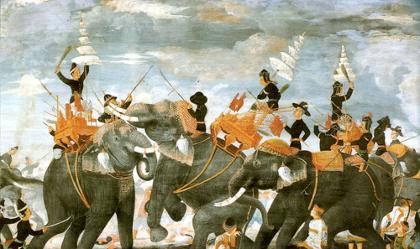
King Maha Thammaracha of Phitsanulok and Prince Ramesuan pursued the Burman King Tabinshwehti as he took the northern route back to his homeland. They were ambushed and captured and ransomed. Among the payment demanded by King Tabinshwehti was two white elephants that had blessed the first year of King Maha Chakkraphat's reign. The elephants proved troublesome and were returned but their significance remained in the mind of General Bayinnaung, second-in-command to King Tabinshwehti.
Opposite: Burman Nat (religious symbol) of King Tabinshwehti.
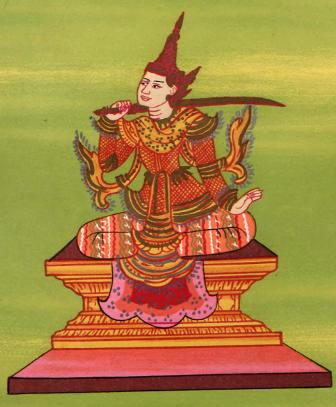
Following the death of King Tabinshwehti, the Burman throne was won by King Bayinnaung. He has been described by the historian G.E. Harvey as 'the greatest explosion of human energy ever seen in Burma.' His story is recounted, along with the other Kings of the Toungoo Empire in my novel of the same name. He wanted revenge on Ayutthaya and mounted a huge and well-organised attack that deposed King Maha Chakkraphat and made Ayutthaya part of the expanding Toungoo Empire. As I say in my blurb for the book 'the largest empire you have never heard of.'
In what has been dubbed 'The Second War of the White Elephant', King Bayinnaung opened his conquest by asking King Maha Chakkraphat for two white elephants. By the thinking that prevailed at the time, to do so would have shown acceptance of suzerainty to the Toungoo Empire. The Kingdom of Ayutthaya chose to fight.
Opposite: The King Bayinnaung statue outside the National Museum of Myanmar.
Maha Thammaracha, the king of Sukhothai in Phitsanulok and a 'lesser' king allied himself with King Bayinnaung and join the attack on Ayutthaya. The reasons for this are unclear. It could have been that he saw defeat as inevitable and changed sides. At this time in history, the sense of country and nationhood did not exist in this part of the world. The traditional concept of 'mandala,' an area of control, still remained. Whatever the reason King Maha Thammaracha allied himself with King Bayinnaung and attacked Ayutthaya. The full story, or my take on it, can be found in my novel 'The Kings of Ayutthaya.'
After time and events had passed, including a siege on Phitsanulok by the Lan Xang (Lao) King Setthathirath supported by Prince Mahin the eldest son of King Maha Chakkraphat, King Bayinnaung made King Maha Thammaracha king of Ayutthaya as King Sanpet I. In doing so the 'Sukhothai Dynasty' acceded to the throne, although one paying homage to the Toungoo Empire. As surety, the Kings sons Prince Naresuan and Prince Ekathotsarot, both born in the Chan Palace in Phitsanulok were taken to Pegu, the capital of the Toungoo Empire as hostages.
King Naresuan
When I arrived in Phitsanulok there was one incident that piqued my interest in Thai history and illustrates the on-going importance of King Naresuan the Great to the nation of Thailand. In Phitsanulok, the birthplace of King Naresuan, stands the temple known locally as Wat Yi, Wat Phra Rattana Mahathat. One day a cavalcade of cars passed through Phitsanulok. Inside were successful Muay Thai fighters together with their managers and trainers, coming to honor both King Naresuan, who was a leading exponent, and pay homahe to the Buddha image of Phra Buddha Chinnarat following their recent international victories. This is something that Muay Thai fighters have done for many previous years, and will continue to do so long into the future.Maha Thammaracha of Phitsanulok and Prince Ramesuan pursued the Burman King Tabinshwehti as he took the northern route back to his homeland. They were ambushed and captured and ransomed. Among the payment demanded by King Tabinshwehti was two white elephants that had blessed the first year of King Maha Chakkraphat's reign. The elephants proved troublesome and were returned but their significance remained in the mind of General Bayinnaung, second-in-command to King Tabinshwehti.
It was while held hostage in Pegu that Thailand's greatest hero emerged. Prince Naresuan, born in Phitsanulok, took responsibility from freeing the Kingdom of Ayutthaya from the yoke of the Toungoo Empire. Tributes, in the form of a fighting cocks can be found throughout Phitsanulok Province.
At military school in Pegu, an early friendship with Mingyi Swa, the son of Nanda Bayin the heir-apparent to the Burman throne soured. Mingyi Swa challenged Prince Naresuan to a cockfight, a popular pastime. It is reputed that Prince Naresuan said that 'if my cock wins then Ayutthaya is free.” To Mingyi Swa, Ayutthaya was just a small part of the vast Toungoo Empire but he took the inference seriously. He added 'a war slave animal,' inferring that even if Prince Naresuan won his kingdom would still be a vassal state of the Toungoo Empire. On a dirt patch worn down by the feet of generations, the two fighting cocks fought until the cock of Prince Naresuan killed that of Mingyi Swa. This was the first move toward the Kingdom of Ayutthaya freeing itself from the Toungoo Empire.

Prince Naresuan and his brother Prince Ekathotsarot returned to Ayutthaya when they were of age. Already acknowledged as a skilled warrior Prince Naresuan was welcomed by his father, King Maha Thammaracha who made him Upparat (heir-apparent) in Phitsanulok, away from the prying eyes of their Burman overseers. Called on to fight for King Bayinnaung it is reputed that Prince Naresuan survived an assassination attempt while fighting in the northern kingdom of Lan Xang by feigning smallpox. King Bayinnaung died on 10 October 1581. The succession was not disputed however his heir King Nanda Bayin faced holding together a vast empire which owed its loyalty to one man, his father. The stories leading to Ayutthayan independence are legendary. The king of the mountain-top fortress of Muang Khan failed to attend the coronation of King Nanda Bayin. In retribution, the new Burman king sent his son Crown Prince Mingyi Swa to quell the revolt. He failed, only to see his childhood rival Prince Naresuan succeed. An attempt was made on Prince Naresuan's life but forewarned by two friends he escaped the trap that Mingyi Swa had laid for him..Prince Naresuan left Burma but paused at the town of Muang Khraeng and on the third of May, 1584 poured holy water from a cup onto the ground with the words:
Because the King of Hongsawadee (Burma) has not adhered to the ways of faithful friendship and royal tradition … Ayutthaya and Hongsawadee shall not form a single golden kingdom as in the past, but shall be totally divorced from each other from this day.'
Statue of King Naresuan at Wat Yi Chaimonkol.
After releasing many of the Siamese captives held in Pegu and pursued by Mingyi Swa he crossed the Sittaung River. Looking back Prince Naresuan saw the Burman General Surakamma astride his elephant. With what became known as 'the shot across the Sittaung River' King Naresuan shot and killed the general. For many years the musket formed part of the Siamese royal regalia. There followed a series of five attempted invasions of Ayutthaya by the Burmese in order to regain their lost city. His father King Maha Thammaracha died in 1590 and he became King Naresuan and earning the sobriquet 'the Great.' The final battle was the Battle of Nong Sarai located outside of Suphanburi near the Thakhoi River. The Burmese troops held the upper hand until King Naresuan spotted the Burmese Crown Prince atop his elephant. Despite many soldiers dressed to look like Mingyi Swa, it was only the real one who could wear a certain amulet. It is reputed that King Naresuan recognised the amulet and asked the following of his childhood nemesis:
'My brother, whatever is our royal older brother doing under the shade of a tree? Come forth and let us fight an elephant duel for the honour of our kingdoms. No future kings will do what what we are going to do.'
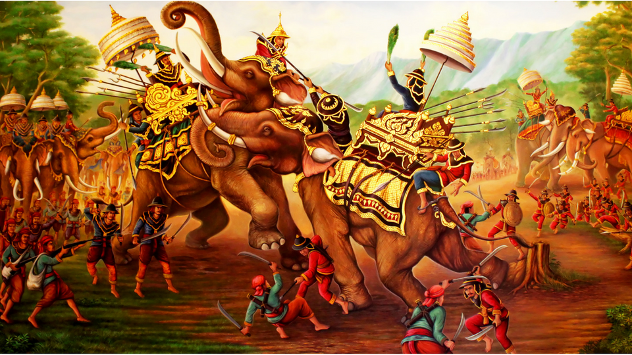
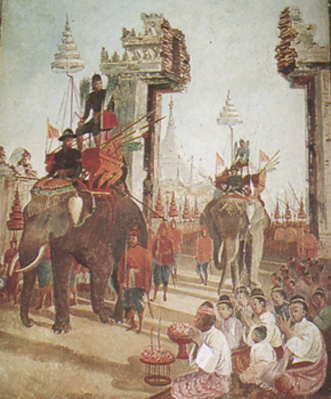
King Naresuan triumphed and the Burmese retreated not to return for two centuries. The battle and Phitsanulok's most famous son, Thailand's national hero is remembered in the statue of 'The Great Battle of Yuttahadhi' at Mueang Boran in Samut Prakan Province as well as on Royal Armed Forces Day on the 18th January each year, on banknotes, on film and T.V, and by having Phitsanulok's university, Naresuan University named in his honour. King Naresuan went on to play a major role in dismantling the Toungoo Empire before his death in 1605.
The picture opposite shows KIng Naresuan leading his troops into Pegu, the capital of the Toungoo Empire only to find he had been double-crossed by his allies who got there first.
King Naresuan triumphed and the Burmese retreated not to return for two centuries. The battle and Phitsanulok's most famous son, Thailand's national hero is remembered in the statue of 'The Great Battle of Yuttahadhi' at Mueang Boran in Samut Prakan Province (Opposite)as well as on Royal Armed Forces Day on the 18th January each year, on banknotes, on film and T.V, and by having Phitsanulok's university, Naresuan University named in his honour. King Naresuan went on to play a major role in dismantling the Toungoo Empire before his death in 1605.
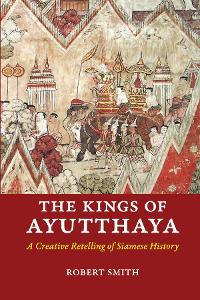
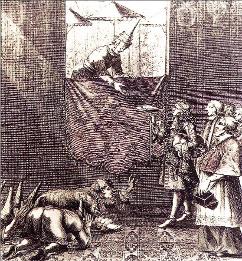
King Narai the Great, the second of the Ayutthayan Kings to be honoured with the sobriquet "the Great" visited Wat Chula Mani during his reign where he left a holy footprint of Buddha and a stone inscription situated inside the Mondop (Building) King Narai spent much of time in Lopburi where he oversaw major changes to the Kingdom.
Phitsanulok served as the second city until the Burmese returned first under King Alaungpaya and later by his son King Hsinbyushin in 1765. Three Burmese led armies attacked, one coming north from the Malay Peninsula, one from the Three Pagodas Pass over the Tenasserim Hills, and one from the north under General Ne Myo Thihapate (pictured opposite) which bore down on Phisanulok.e
The Burman army took both Sukhothai and Phitsanulok before all three of their armies converged on Ayutthaya. The city was ravished and its artifacts and gold stolen. Ayutthaya was abandoned, but within a few decades a new capital Bangkok was founded, and a new dynasty reigned.
Opposite: Aung Pinle Hsinbyushin nat (spirit), in the official pantheon of Burmese nats
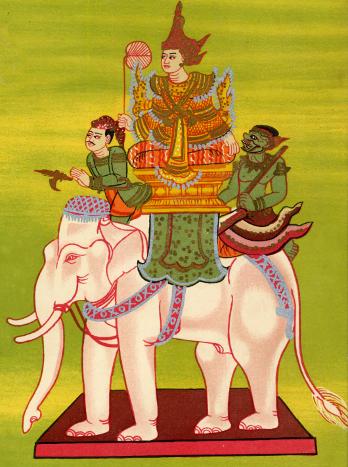
"The sinful Burmese ravaged our villages and cities. A great number of our citizens and many temples were killed and ruined. Our peaceful kingdom was abandoned and turned into forest. The Burmese showed no mercy to the Thai and felt no shame for all the sins they had committed."
Account of Maha Sura Singhanat.
Later, in 1765, Governor Rueang of Phitsanulok, Commander of Northern Military affairs was commanded by the Ayutthayan king, King Ekkathat to raise an army and relieve Chiang Mai from a Burman incursion. This soon became recognized as a full-scale invasion. By the time Governor Rueang drew close the city had fallen. His army fought a stern rearguard action against the advancing Burman army under Ne Myo Thihapate, fighting to defend Tak, Raheng, Kamphaeng Phet, Sawankhalok, Sukhothai, Rathama, and Phitsanulok which ultimately resisted the Burmese army. By the end of these battles the Siamese army was routed but not without causing severe losses to the Burmese.
During the interim period Prince Chit who had attempted to usurp the throne of Ayutthaya bribed his guards and escaped from the custody of King Ekkathat. He and his followers seized Phitsanulok during Governor Rueang’s absence burning the governor’s residence in the process and claiming himself as Governor of Phitsanulok. Governor Rueang’s wife, Lady Qingchaing fled upriver to Sukhothai to inform her husband who returned to Phitsanulok and defeated Prince Chit who was later drowned in the Nan River. His followers were all executed with the exception of his daughter. Governor Rueang citing the Kings Powers in time of war.
The Burman king. King Hsinbyushin found himself under threat from a Chinese Imperial Army advancing toward his capital in Ava. His order led to the hasty withdrawal of Burmese forces, leaving behind a holding army to control Ayutthaya and its provinces. When the Burmese departed they took with them their booty and over 30,000 prisoners together with approximately 10,000 members of the royal family, artisans, the literati, and monks, leaving behind a nation with its ruling class decimated, its manpower depleted, families torn apart, and the immediate threat of famine.
In 1768, Governor Rueang proclaimed himself as King of Siam. His kingdom encompassing Phitsanulok and part of Nakhon Sawan. His reign was short as he died six months after the proclamation was made and only seven days after his coronation with a number of causes such as a coughing fit, abscesses, scrofula, and smallpox all being given as the conflicting reasons for his death. After his death Phitsanulok came under the rule of Chao Phra Fang, a local lord from the town of Fang (modern day Uttaradit).
To the south it took only six months for Colonel (later King) Taksin to regroup and force out the remaining Burmese troops from Ayutthaya and the Siamese heartlands. With the city of Ayutthaya now destroyed Taksin established a new capital at Thonburi as the cultural and administrative center of the new kingdom where he sought to establish an adequate militia and reestablish economic and food security.
Colonel Taksin had proven himself as an able warrior and leader and surrounded himself with able and proven men among them the brothers Duang and Bunma who both quickly rose through the ranks gaining the ranks of General Chakri and General Surasi. Taksin was consecrated as king in Thonburi in December 1767 with a formal coronation taking place in December of 1768. Faced with the aftermath of the fall of Ayutthaya and others calling themselves king, he mounted a series of military expeditions in the East against Phimai (1768), Nakhom Si Thammarat (1769), and the northern Chao Phra Fang insurrection spreading from Sawangkburi and encompassing Phitsanulok (1770). Phitsanulok had its defenses weakened as a series of raids by Chao Phra Fang that had left the city vulnerable, however a virulent epidemic in the city brought about an easy victory for newly installed King Taksin.
King Hsinbyushin who had had to abandon his earlier successful 1767 Ayutthaya campaign and recall his troops to fight an Imperial Chinese incursion had reached a peace agreement and was now focused on completing his conquest of the Kingdom of Ayutthaya. With 40,000 troops available to him, half of what he had in the 1767 invasion, he decided on a strike over the Tenasserim Hills via the Myawaddy Pass toward Phitsanulok under his general Maha Thiha Thura dividing the country and then systematically destroying the upper and lower halves. King Taksin having been involved in the suppression of the rebel kingdoms also had less troops than ten years earlier. Despite superior morale and flexibility of the Siamese army the greater numbers of the Burmese forces gradually prevailed.
King Taksin’s army had gradually been deprived of troops who went to both Chiang Mai and the southern Mon in support of insurrections fomented by King Hsinbyushin leaving the center of the country vulnerable. The lords of Chiang Mai, Lamphun, and Lampang offered their vassalage to Siam in return for protection. The Siamese army led by General Chakri and his younger brother General Surasi marched north in support with King Taksin following with additional forces from Thonburi. To the south over 10,000 Mon fled the advancing Burman soldiers giving King Hsinbyushin reason for a cross-border incursion and causing King Taksin to rethink his strategy and return south earlier than anticipated.
Meanwhile the Burmese commander Maha Thiha Thura continued his advance on Sukhothai and Phitsanulok. Surprised by the speed of his advance King Taksin gathered an army of 12,000 men and moved toward Phitsanulok where General Chakri was currently entrenched. General Surasi and his troops arrived exhausted in Phitsanulok following a forced march from Chiang Mai. They awaited the arrival of King Taksin strengthening the defenses and extending booms across the Nan River. As the army of Maha Thiha Thura established themselves facing Phitsanulok a gradual stalemate developed as both sides for an opening.
The opening came when Burmese commandos disrupted a convoy of rice with their Jingals (early transportable cannon) and disrupted water traffic by blocking the river. With their supply line interrupted the fear of food shortages raised its head. Gradually the defense of Phitsanulok ebbed under the successful generalship of Maha Thiha Thura causing King Taksin to retreat to Pichit. Generals Chakri and Surasi were left to prepare an evacuation plan for the citizenry of Phitsanulok. In a face-saving exercise the citizenry feinted an attack against the Burmese before running back into the city. The remaining guns fired on the pursuing Burmese until all ammunition was gone. By that time, the population had largely left the city.
They left behind an empty city save for 500 elderly and infirm under the care of monks. Wells were poisoned, everything of value was destroyed or had accompanied the evacuees leaving an empty city. With little of value and nothing to be gained chasing those fleeing the city the Burmese settled down and took stock. Food began to run short and rumors of the failing health of King Hsinbyushin were confirmed when they were advised of his death. Maha Thiha Thura withdrew his troops to Sukhothai where they had amassed the booty from the campaign but not before dismantling Phitsanulok’s city walls and leaving a charred and derelict city.
The Burmese invaded again in 1785 but by that time Phitsanulok had been largely abandoned. The Phra Buddha Chinnarat was left largely untouched by the Burmese and removed to Wat Baworn Niwet in Bangkok in 1829. Gradually and following forced attempts to re-populate the city it slowly grew, rebuilt, and established itself once more.
